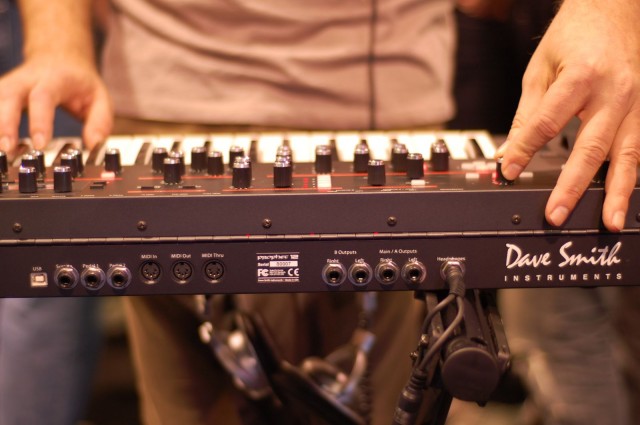The Prophet 12 from Dave Smith Instruments is a landmark synth: packed with polyphony and sound features, it’s the latest demonstration that “new” and “synth keyboard” can go together. So, for our first-look tour through the new Prophet, we get a special treat – writer, electronic musician, and mathematician Gina Collecchia got a hands-on look with the engineers who designed the instrument. Gina, who demystifies signal processing for all the rest of us in her book Numbers and Notes, get to talk with Chris, one technologist to another. -Ed.
Meet the newest member of the Dave Smith Instruments family: the Prophet 12! A hybrid synthesizer that mixes analog circuits with digital synthesis, this instrument represents a lot of “firsts” for the pioneering, San Francisco-based company. I sat down with three of Dave Smith’s engineers at this year’s NAMM in Anaheim, CA, and got the scoop on what’s different about the Prophet 12.
Following the naming convention of the Prophet 5 and the Prophet 8, the newest Prophet has 12 voices. Signals begin in the digital domain with digital oscillators. Every voice can have four of them, PLUS a “sub-oscillator,” humming an octave below the fundamental frequency.
Sixty oscillators. This alone should indicate the magnificent range of sounds you can get out of this beast. From classic synth tones to cinematic soundscapes, the Prophet 12 is a marvel. Interesting, then, that I consider it the most transparent synthesizer I’ve ever seen. Its design has an emphasis on clarity for musicians to really understand how their sound is crafted and choose knobs with confidence.

Diagram of the signal flow in the DSI Prophet 12. The digital portion is colored blue while analog is orange-tinted.
The digital effects, accessed in the “Character” region of knobs, have charming names like Hack, Decimation, Drive, Girth, and Air. The first two could only be done in the digital domain: Hack crunches bits and Decimation does sample rate reduction. Drive is the familiar effect of overdrive and Air/Girth are two high and low shelf filters that have, you know, airy and girthsome properties.
Beyond the effects unit, the remainder of the synthesizer is analog. The signal is passed through resonant, 2- or 4-pole, low pass and high pass filters with a 14 octave frequency response–a whole octave greater than the Prophet 8.
The VCAs control panning and ADSR envelopes, and then the signal reaches a tuned feedback loop (“Dave’s Fave!”) that’s wired up with the same technology as that from the DSI Poly Evolver. Cranking up the resonance of the low and high pass filters gives the feedback more prominence. Multitap delay lines (4 per voice!) are placed in the Prophet 12 next to the analog path to simulate effects like flanging and reverb. All of these voices are then summed and routed to a pair of stereo analog distortion units with wet/dry hardware mix.
The user interface of the Prophet 12 is perhaps the most dramatic element of the makeover.

The display on the Prophet 12 is clean and the updated controls make it easier to use than ever. (Click for a closer look.)
Menu selection is performed via tabs and buttons instead of arrows. Assigning sources and destinations is a breeze in the Modulation region, mapping controllers and knobs intuitively to anything else. A clever sort algorithm provides graphical display of what’s affecting what in the 16-deep modulation array. Using the “Show” button, any parameter can be viewed without changing the sound as knobs are touched.
Presets can be stored in “playlists” and accessed with the program buttons, a feature designed with keyboardists in mind.
Four LFOs per voice can also be piled on, and since they go up to 500 Hz, these are essentially 48 more oscillators! ONE HUNDRED AND EIGHT OSCILLATORS. Since these too are digital, there’s much less voltage control to take care of in the Prophet 12. The voltage control that does occur is updated at a rate of 11 kHz. These LFOs are syncable to the internal MIDI clock or the new 32-step programable arpeggiator in the place of a step sequencer. The high update rate provides a buttery smooth texture to the modulation, and makes the synth’s sound pretty much indistinguishable from that of any analog synth.
There were many other advantages to going (partially) digital in the Prophet 12. “Digital is way more flexible,” says engineer Chris Hector. “Analog oscillators are not really stable enough for FM synthesis. The oscillators have lower than ever aliasing to clean up even more digital artifacts. And, the digital effects are where it’s at for the characteristic DSI sound.”
Oscillators are stacked in the Prophet 12 such that Osc 2 modulates Osc 1, Osc 3 modulates Osc 2, and Osc 4 modulates the third. Therefore, this mean machine can do subtractive, wavetable, FM, and AM synthesis, and any combination thereof. You wouldn’t think from just the look of it that the Prophet 12 had such range, but its design maximizes both simplicity and possibility. And to me, that’s the number one goal in new instrument design.
http://www.davesmithinstruments.com/
Gina, like CDM’s editor-in-chief, is a previous resident of Louisville, Kentucky. Maybe there really is something in that water the bourbon and racehorses like so much. She is now at Stanford University. -Ed.

